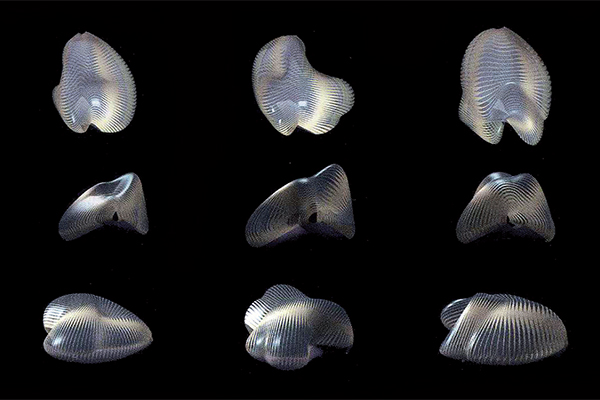Of morphogenetic images. Five notes between science, art and architecture
DOI:
https://doi.org/10.15168/xy.v1i1.21Abstract
The repertoire of images derived from the formation of morphogenetic processes has been widely investigated in any scientific and humanistic study sector: from the pioneering kinetic art experiences, programmed art and generative art of the 60s and 70s, to digital spatiality and digital utopian architecture projects or morphogenetic architecture, to the 90s or recent experience, you can have a look at these currents with a critical eye which is in part appropriately detached given the temporal distance that has come to develop. Kinetic Art, Programmed Art, Generative Art, de–formative Architecture, and other names1 to indicate the processes and application experiences in different fields but which are derived from a common intellectual matrix: to generate forms, shapes, images or spaces from automated IT processes that do not delineate as a deterministic figuration from the hands of the author but as interaction between the author himself or herself and a computational thinking declined in various ways.
References
AA. VV., 1997. Peter Eisenman. 1990–1997. El Croquis. 83, 1997, pp. 170.
CHU, K., 1998. The Cone of Immanenscendence. ANY. 23, Diagram works: Data Mechanics for a topological age, 1998, pp. 39–41.
COSTA, M., 2005. Dimenticare l’arte. Nuovi orientamenti nella teoria e nella sperimentazione estetica. Milano: Franco Angeli, pp. 142.
DE KERCKHOVE, D., 2001. L’architettura dell’intelligenza. Torino: Testo & Immagine, pp. 93.
DE RUBERTIS, R., 1994. Il disegno dell’architettura. Roma: N.I.S., pp. 266.
EISENMAN, P., 1992. Oltre lo sguardo. L’architettura nell’era dei media elettronici. Domus. 734, 1992, pp. 17-24.
KIPNIS, J., 1993. Towards a new architecture. AD Profile. 102, 1993, pp. 97–116.
KONING, H., EIZENBERG, J., 1981. The language of the prairie: Frank Lloyd Wright’s prairie houses. Environment and Planning. B, 1981, pp. 295–323.
LANGELLA, C., 2011. L’evoluzione del progetto bio–ispirato. Scienza e Filosofia. 6, 2011, pp. 9–16.
LEVINE, J., 2010. Towards the Edge of Chaos: An Interview with Leonardo Solaas. Digimac Issue 51. 2010. [visitato 30 gennaio 2016]. Disponibile da: http://www.digicult.it/digimag/issue-051/towards-the-edge-of-chaos-an-interviewwith-leonardo-solaas/.
LEVY, P., 1997. Il Virtuale. Milano: Cortina Editore, pp. 148.
LONGHI, R., 1975. Fatti di Masolino e di Masaccio e altri studi sul Quattrocento (1910-1967). Firenze: Sansoni, pp. 250.
LUIGINI, A., 2001. Digital Tectonics. Verso un nuovo paradigma digitale. XY dimensioni del disegno. 41–42–43, 2001, pp. 64–68.
LUIGINI, A., 2004. Disegno digitale e progetto: elementi per una tassonomia. In AA. VV., Il progetto del Disegno. Atti del 1° Congresso UID, Lerici, 14–16 ottobre 2004. Lerici, pp. 240–243.
LYNN, G., 1993. Folding in Architecture. AD profile. 102, 1993, pp. 112.
LYNN, G., 1996. From body to blob. In DAVIDSON C. (a cura di), ANY Body. New York: Anyone Corporation, pp. 161–173.
LYNN, G., 1998. Embriological housing. ANY. 23, 1998, pp. 47–50.
LYNN, G., 1999. Animate Form. New York: Princeton Press, pp. 204.
MANCUSO, M., 2008. Generative Nature. Estetica, ripetitività, selezione e adattamento. Digicult. 2008. [visitato 30 gennaio 2016]. Disponibile da: http://www.digicult.it/it/the-agency/lectures/generative-nature-fabrica-workshop.
MENEGUZZO, M., MORTEO, E., SAIBENE, A., (a cura di), 2012. Programmare l’Arte. Olivetti e le neoavanguardie cinetiche. Monza: Johan & Levi editore, pp. 179.
PIERSANTI, N., LONGO, G., 2012. Le equazioni della natura. Sapere. Agosto, 2012, pp. 28–31.
PURINI, F., 2003. Digital Divide. In SACCHI, L., UNALI, M. (a cura di), Architettura e cultura digitale. Milano: Skira, pp. 87–96.
ROWE, C., 1956. La matematica della villa ideale e altri scritti. Bologna: Zanichelli, pp. 240.
SACCHI, L., DE FUSCO, R., 2000. Il codice dei limiti. L’architettura alla fine del secolo XX. In DE FUSCO, R., Storia dell’architettura contemporanea. Bari: Laterza, pp. 617‒756.
SACCHI, L., UNALI, M. (a cura di), 2003. Architettura e cultura digitale. Milano: Skira, pp. 247. STEADMAN, P., 1988. L’evoluzione del design. L’analogia biologica in architettura e nelle arti applicate. Trad. it. di F. Cavaliere. Napoli: Liguori, pp. 323.
STINY, G., MITCHELL, W. J., 1978. The Palladian Grammar e Counting Palladian Plans. Environment and Planning. B, 1978, vol. 5, pp. 5–18.
THOMSON, D’ARCY W., 2006. Crescita e Forma. La geometria della natura. Ed. ridotta a cura di J. T. Bonner (ed. orig. On Growth and Form, 1917–1942). Torino: Bollati Boringhieri, pp. 360.


